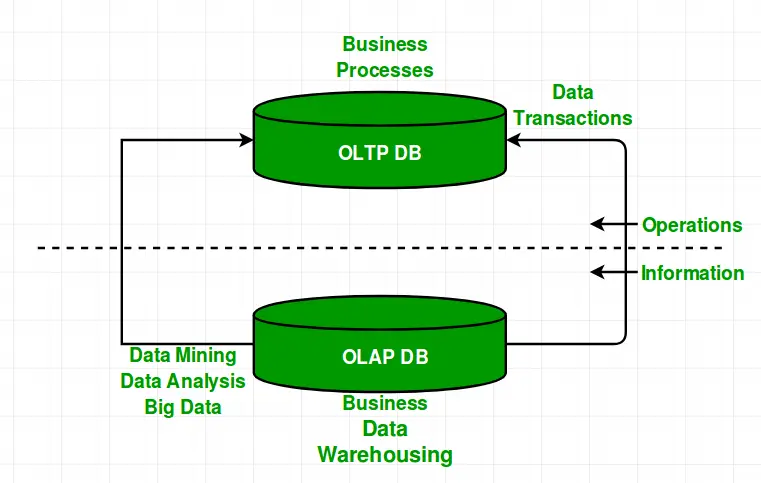While OLTP is an acronym for online transaction processing (OLTP), OLAP is an acronym for online analytical processing (OLAP). Both OLTP and OLAP are online processing systems. There is a fundamental distinction between OLTP and OLAP in that while OLTP is concerned with transaction processing, OLAP is much more concerned with analytical processing. Transactions are separate functions that are in charge of handling the data in a database, as opposed to rows and columns. Transactional data is stored in Relational Databases (RDBMS).
What is OLTP?
OLTP is a type of database that is intended to serve as a permanent data storage for enterprise applications or front-end applications. The online transaction processing (OLTP) system manages the day-to-day operations of a company. The opportunity to look for detailed information rapidly as well as to conduct large numbers of brief online transactions sets them apart from the competition (INSERT, UPDATE, DELETE).
The primary focus of online transaction processing (OLTP) systems is on extremely quick query processing, ensuring data integrity in multi-access situations and efficiency as determined by the number of operations per second. In online transaction processing (OLTP) databases, there is comprehensive and updated data, and the entity structure is the schema used to hold transactional databases (usually 3NF).
What is OLAP?
OLAP databases, also known as Online Analytical Processing databases, are used to hold data that has been aggregated from several OLTP databases. After that, the information is kept in a data warehouse. However, it provides a multidimensional perspective of the data rather than a transaction-level view. The collected sales data can be seen in a variety of ways depending on the organization’s needs, such as geography (region, nation, state), time of year (month), day of the week, and even by the customer’s gender and age, among other things. It is possible for enterprises to undertake advanced analyses on their data, resulting in a more in-depth understanding of their respective products.
Difference between OLTP and OLAP

- When it comes to online analytical processing (OLAP) systems, data warehousing excels because the objective is efficient and precise evaluation of a huge volume of data from numerous sources in order to generate insights that drive additional actions & guide future actions. Huge amounts of data and information on day-to-day transactions are collected by OLAP systems from online transaction processing (OLTP) databases.
- OLAP databases could be used to construct what is referred to as an OLAP cube, which is a type of data visualization. Instead of serving as a puzzle to be solved, an OLAP cube aids in problem-solving by displaying the complicated, interconnected data stored within the associated databases of an OLAP database system as a three-dimensional cube that is easy to understand. End users can “slice and dice” information when it is presented in this manner, allowing them to discover data correlations and get insights that would otherwise have been difficult to discover.
- An OLTP system is much more strategic and rapid in its application with procurement automation compared to an OLAP system, as it focuses on processes that are constant, frequent, and generally straightforward. Online transaction processing (OLTP) systems generate the data that online analytical processing (OLAP) systems use to accomplish strategic improvements.
| Parameters | OLTP | OLAP |
| Primary Objective | Processing and controlling fundamental business tasks. | For planning, decision making, and problem-solving. |
| Source of data | Operational data; the original source of the data. | Consolidation data; data rendered from different OLTP Databases. |
| Database Type | Traditional DBMS. | Data warehouse. |
| Response time | In Milliseconds. | Little slow. |
| Quality of data | Detailed & organized data. | Disorganized data. |
| Number of Indices or Indexes | Limited. | Much more. |
| Queries | Quick and simple takes only a few seconds. | Complex, with aggregating. |
| Backup and Recovery | Make regular backups; operational data is crucial to the operation of the firm, and data loss will almost certainly result in considerable monetary loss and legal consequences. | Despite the fact that regular backups are always the safer option, certain systems may consider just reloading the OLTP data as just a recovery solution in certain circumstances. |
Conclusion
An online data altering scheme is referred to as OLTP, whereas an online multidimensional analytical data extraction technology is referred to as OLAP, which retrieves data for the analysis to assist in making strategic decisions online. Since they perform two distinct purposes, how or when to employ them is dependent on the demands of the client.
The post OLTP vs OLAP – Difference between OLTP and OLAP appeared first on The Crazy Programmer.
from The Crazy Programmer https://ift.tt/3aJsXLh
Comments
Post a Comment